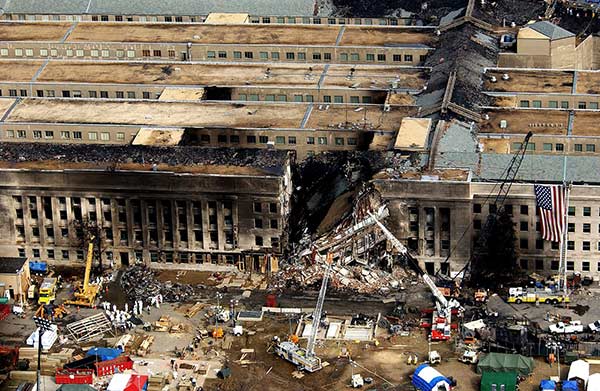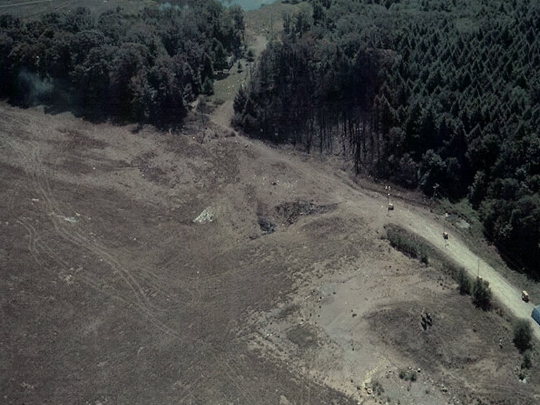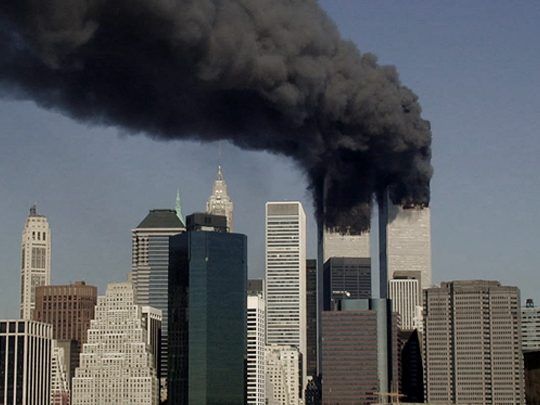Photo by Michael Foran / Wikimedia Commons / CC-BY-SA-3.0 / GFDL
1 – The September 11 Attacks
The September 11 attacks (also known as 9/11) were four coordinated terrorist attacks by the Islamic terrorist group al-Qaeda against the United States on the morning of 11 September 2001.
Four passenger airliners, operated by United Airlines and American Airlines, were hijacked by 19 al-Qaeda terrorists.
Each of the planes had departed from the northeastern United States bound for California.
In total, the attacks killed 2,996 people, injuring over 6,000, and caused infrastructure and property damage estimated to be worth at least $10 billion.
The United States responded by launching the War on Terror and invading Afghanistan. The ruling Taliban had failed to comply with U.S. demands to extradite Osama bin Laden and expel al-Qaeda from the country.
After claiming responsibility for the attacks, bin Laden cited U.S. support of Israel, U.S. troops in Saudi Arabia, and sanctions against Iraq as motives.
In May 2011 bin Laden was located in Abbottabad, Pakistan and killed by U.S. Navy SEAL Team Six.
9/11 is the single deadliest terrorist attack in human history and the single deadliest incident for firefighters (343 killed) and law enforcement officers (72 killed) in United States history.
In the years following the attacks, thousands of more people died of cancer and respiratory diseases from the toxic dust around the fallen Trade Center, known as ground zero, in New York City.
2 – Two Hi-Jacked Planes Crash Into the World Trade Center

Two planes, American Airlines Flight 11 and United Airlines Flight 175, crashed into the North and South towers of the World Trade Center in Lower Manhattan.
The first aircraft crashed into the North Tower at 08:46:40 local time.
French Documentary filmmakers Jules and Thomas Naudet captured the only known footage of the initial impact from start to finish.
In less than two hours, both of the 110-story towers collapsed. Falling debris and fires also led to the collapse of the 47-story World Trade Center tower 7, as well as significant damage to ten other nearby buildings.
The destruction of the World Trade Center and nearby infrastructure seriously harmed the American economy and had a significant effect on global markets.
Cleanup of the World Trade Center site was completed in May 2002, and the Pentagon was repaired within a year.
On 18 November 2006, the construction of One World Trade Center began at the World Trade Center site and was officially opened on November 3, 2014.
3 – The Pentagon is Also Attacked on 9/11

American Airlines Flight 77 was crashed into the Pentagon (the headquarters of the U.S. Department of Defense) in Arlington County, Virginia, near Washington, D.C.
The Boeing aircraft was hijacked by five members of al-Qaeda and crashed into the Pentagon, killing all 64 people on board. The crash also killed 125 people in the building.
Less than 35 minutes after take-off, the hijackers stormed the cockpit, while forcing the passengers, crew, and pilots to the rear of the aircraft.
The aircraft was crashed into the western side of the Pentagon at 09:37 EDT.
The impact severely damaged and collapsed a section of the Pentagon, also causing a large fire. The rebuild of the damaged sections of the Pentagon was completed in 2002.
The 184 victims of the attack are memorialized in the Pentagon Memorial near the crash site, which contains a bench for each of the victims, arranged according to their year of birth.
4 – United Airlines Flight 93 Crashes in Pennsylvania on 9/11

The fourth plane, United Airlines Flight 93, was initially flown toward Washington, D.C., but crashed into a field in Stonycreek Township near Shanksville, Pennsylvania.
The flight was hijacked when four al-Qaeda terrorists stormed the cockpit 46 minutes after takeoff as part of the September 11 attacks.
However, it crashed during an attempt by the passengers and crew to regain control.
All 44 people on board were killed, but no one on the ground was injured. The aircraft was on its daily scheduled morning flight from Newark Airport in New Jersey to San Francisco, California.
Khalid Sheikh Mohammed, who is considered the architect of the attacks, has subsequently claimed that the Capitol Building in Washington, D.C. was the intended target.
After the hijackers had taken control of the plane, a number of passengers and flight attendants learned from phone calls that other hijacked airliners had attacked the World Trade Center and the Pentagon.
The passengers then attempted to regain control of the aircraft, which ultimately saw the plane crash into a field in Stonycreek Township, near Shanksville. It was the only aircraft that did not reach its hijackers’ intended target on 9/11.
Construction of a permanent Flight 93 National Memorial was dedicated on 10 September 2011, with a visitor center opened four years later in 2015.
5 – The War in Afghanistan Begins

The War in Afghanistan began with the United States invasion of Afghanistan on 7 October 2001. The U.S. was supported by the United Kingdom, Canada, and Australia and a coalition of over 40 countries.
The initial aims were of the war were to dismantle al-Qaeda and to remove the Taliban from power. However, as these initial goals were completed at the end of 2001, the majority of the war has involved the U.S. and allied Afghan troops battling Taliban insurgents.
Following the September 11 attacks, U.S. President George W. Bush demanded the ruling Taliban hand over Osama bin Laden. However, they declined unless they were provided clear evidence of his involvement.
The U.S. dismissed this as a delaying tactic and launched Operation Enduring Freedom alongside the United Kingdom in October.
The United Nations Security Council established the International Security Assistance Force (ISAF) to assist the new Afghan Interim Authority with securing Kabul.
NATO became involved in ISAF in August 2003, and later that year assumed leadership of it. One portion of U.S. forces in Afghanistan operated under NATO command; the rest remained under direct U.S. command.
Following defeat in the initial invasion, the Taliban was reorganized by its leader Mullah Omar and launched an insurgency in 2003, reasserting their influence across rural areas of southern and eastern Afghanistan.
In October 2014, British forces officially ended their combat operations by handing over the last of their bases in Helmand to the Afghan military.
Over 10,000 foreign troops remain in Afghanistan without any formal plans to withdraw, continuing their fight against the Taliban. The War in Afghanistan is now the longest war in U.S. history.
Since the war began, tens of thousands of people have been killed. Over 4,000 ISAF soldiers and over 62,000 Afghan national security forces were killed, as well as over 31,000 civilians and at least as many Taliban fighters.
6 – Apple Launches the iPod

The iPod portable media player was first designed, marketed, and released by Apple Inc. on October 23, 2001, about eight and a half months after the Macintosh version of iTunes was released.
The iPod line came when the company began creating software for the growing market of personal digital devices.
The company had found digital music players were not fit for purpose, in both size and usability.
Apple CEO Steve Jobs ordered hardware engineering chief Jon Rubinstein and a team of engineers, including hardware engineers Tony Fadell and Michael Dhuey, and design engineer Sir Jonathan Ive, to design the iPod line.
Christened “the Walkman of the twenty-first century”, the iPod was developed in less than one year and unveiled by Jobs who announced it as a product with a 5 GB hard drive that puts “1,000 songs in your pocket.”
The iPod has been credited with accelerating shifts within the music industry. As its popularity grew, digital music storage allowed users to choose specific singles, instead of entire albums, which hastened the end of the Album Era in popular music.
7 – Wikipedia is Launched

Wikipedia is a free web-based encyclopedia based on a model of openly editable and viewable content. It is the largest and most popular general reference work on the World Wide Web.
The brainchild of Jimmy Wales and Larry Sanger, Wikipedia was launched on 15 January 2001. Sanger coined its name, as a combination of the Hawai’ian word for quick “wiki” and “encyclopedia“.
Overall, Wikipedia is home to more than 40 million articles in 301 different languages.
In 2014, the website reached 18 billion page views and nearly 500 million unique visitors per month.
In 2006, Time magazine stated Wikipedia’s open-door policy which allows anyone to edit had made the site the biggest and possibly the best encyclopedia in the world.
Wikipedia is owned and supported by the Wikimedia Foundation, a non-profit organization that operates on money it receives from donors.
As of 2018, Wikipedia is one of the most popular websites in the world according to Alexa rank.
8 – Congo President Laurent-Désiré Kabila is Assassinated
Laurent-Désiré Kabila was a Congolese revolutionary and politician who came to power as the third President of the Democratic Republic of the Congo when he overthrew Mobutu Sese Seko on 17 May 1997.
During the 1960s, Kabila and his fellow rebels operated alongside Che Guevara when he came to Congo, planning to bring about a Cuban-style revolution.
In 1967, Kabila and his supporters moved their operation into the mountainous area of South Kivu in the Congo, founding the People’s Revolutionary Party (PRP).
The PRP created a secessionist Marxist state in South Kivu province, with the support of the People’s Republic of China.
In 1988, the PRP state came to an end and Kabila disappeared from the public sphere for a time.
In October 1996, Kabila returned leading ethnic Tutsis against Hutu forces, marking the beginning of the First Congo War.
During the rebellion, Kabila had as many as 10,000 children serving under him in the conflict.
After President Mobutu fled into exile on 16 May, Kabila proclaimed himself president the following day. He suspended the Constitution and changed the name of the country from Zaire to the Democratic Republic of the Congo.
The exact circumstances of Kabila’s assassination are still disputed. A nine-month military trial followed his death, leading to more than 80 people being sentenced to prison.
Most reliable reports state Kabila was shot and killed in his office by his bodyguard on 16 January 2001, reportedly dying on the spot.
However, he was flown to a hospital in Zimbabwe so that authorities could organize for his succession.
The Congolese government announced that he had died of his wounds on 18 January. Kabila was then succeeded by his 29-year-old son Joseph.









